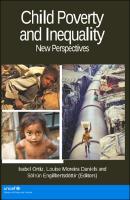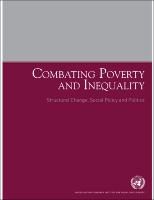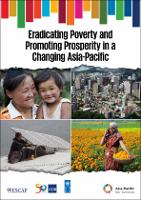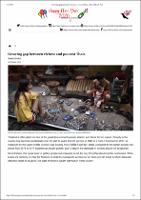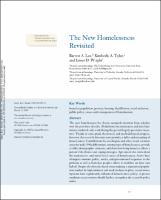Browsing by Subject "Poverty"
Now showing items 1-6 of 6
-
Child Poverty and Inequality: New Perspectives
(2012)
The 21st century starts with vast inequalities for children in terms of income, access to food, water, health, education, housing, or employment for their families. Half of the world’s children are below the poverty line of $2 a day and suffer from multiple deprivations and violations to basic human rights. More than 22,000 children die each day, and most of their deaths are preventable. This volume presents some of the critical acknowledged voices to move a necessary agenda forward. It explains multidimensional poverty measurements, describes ... -
Combating poverty and inequality: structural change, social policy and politics
(United Nations Research Institute for Social Development, 2010)
Poverty reduction is a central feature of the international development agenda and contemporary poverty reduction strategies increasingly focus on “targeting the poor”, yet poverty and inequality remain intractable foes. Combating Poverty and Inequality argues that this is because many current approaches to reducing poverty and inequality fail to consider key institutional, policy and political dimensions that may be both causes of poverty and inequality, and obstacles to their reduction. Moreover, when a substantial proportion of a country’s ... -
Eradicating Poverty and Promoting Prosperity in a Changing Asia-Pacific
(United Nations, 2017-03-01)
This report is produced under a renewed partnership between United Nations (ESCAP), ADB, and the United Nations Development Programme (UNDP) to support national and regional efforts to implement the 2030 Agenda for Sustainable Development. It explores five megatrends that will determine whether everyone will be able to thrive and fulfill their expectations for a better life in the future: regional economic cooperation and integration; rural–urban transitions; demographic changes; ICT access and connectivity; and demand for natural resources. It ... -
Growing gap between richest and poorest Thais
(the ASEAN Post, 2019-10-25) -
Making free public healthcare attractive: optimizing health equity funds in Cambodia
(2018-06-25)
Background: Following the introduction of user fees in Cambodia, Health Equity Funds (HEF) were developed to enable poor people access to public health services by paying public health providers on their behalf, including non-medical costs for hospitalised beneficiaries (HEFB). The national scheme covers 3.1 million pre-identified HEFB. Uptake of benefits, however, has been mixed and a substantial proportion of poor people still initiate care at private facilities where they incur considerable out-of-pocket costs. We examine the benefits of ... -
The New Homelessness Revisited
(Annual Review of Sociology, 2010)
The new homelessness has drawn sustained attention from scholars over the past three decades. Definitional inconsistencies and data limitations rendered early work during this period largely speculative in nature. Thanks to conceptual, theoretical, and methodological progress, however, the research literature now provides a fuller understanding of homelessness. Contributions by sociologists and other social scientists since the mid-1990s differentiate among types of homelessness, provide credible demographic estimates, and show how being homeless ...

